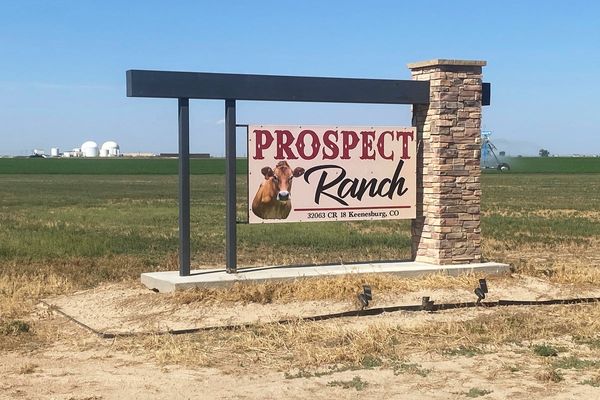LOS ANGELES — The federal government on Tuesday laid out two options for preventing the Colorado River’s depleted reservoirs from falling to critically low levels, saying it could either impose cuts across the Southwest by following the water-rights priority system or by using an across-the-board percentage.
The stakes of this decision are high for California, which receives the largest share of water from the Colorado River. An across-the-board cut could hit California harder, particularly agricultural regions.
The U.S. Bureau of Reclamation presented its alternatives as an initial step in a review aimed at revising the rules for dealing with shortages through 2026. The reductions, if adopted, could affect cities and farming areas in California, Arizona and Nevada.
The river’s largest reservoirs, Lake Mead and Lake Powell, have declined dramatically during 23 years of drought intensified by climate change. Even after storms that have blanketed the Rocky Mountains with the largest snowpack since 1997, federal officials say the likelihood of a return to dry conditions means the region still needs a plan for apportioning additional water cuts if necessary over the next three years.
“Everybody understands the significance of the crisis,” Deputy Interior Secretary Tommy Beaudreau said. “I think everybody understands that, as fortunate and thankful we are for the precipitation, that nobody’s off the hook, and that there needs to continue to be unity in trying to develop solutions.”
Representatives of seven states, water agencies and tribes have been discussing options for reducing water use to prevent the reservoirs from dropping toward dangerously low levels. Closed-door talks are set to continue while the federal government receives input on the proposals.
The Bureau of Reclamation said it released its initial review of alternatives, called a draft supplemental environmental impact statement, to “address the continued potential for low run-off conditions and unprecedented water shortages in the Colorado River Basin.”
The agency is revising the 2007 guidelines for its operations of Glen Canyon Dam and Hoover Dam, which include measures for dealing with shortages through 2026 — but which federal officials say would no longer be sufficient if reservoirs continue to decline.
The Biden administration released its options more than two months after officials from California and six other states presented two conflicting proposals for water reductions.
Under one alternative, the federal government would consider making water reductions based predominantly on the existing priority system for water rights.
That would mean smaller cuts or no cuts for agencies and entities that hold older senior rights, including agricultural suppliers such as California’s Imperial Irrigation District, which uses the single largest share of Colorado River water to supply about 500,000 acres of farmland in the Imperial Valley. Strict adherence to the water-rights priority system would also mean large cuts for junior water rights holders that started taking water from the river later, such as the Central Arizona Project, which supplies Phoenix, Tucson and other cities in Arizona.
Under a second alternative, the Bureau of Reclamation would analyze the effects of reductions “distributed in the same percentage” for all water users in the three Lower Basin states of California, Arizona and Nevada.
This approach would mean across-the-board cuts for all water users in the region, including senior water rights holders, amounting to a reduction of about 13% on top of cuts that were already agreed to under a 2019 deal. Agricultural irrigation districts, cities and tribes would all need to participate based on a schedule of reductions tied to the levels of Lake Mead.
Beaudreau said this second alternative would reflect the Interior secretary’s authorities to “provide for human health and safety” and manage supplies under emergency conditions. If reservoir levels drop further and additional cuts are triggered, this approach would shore up the allocations of agencies with more junior water rights, such as cities in Arizona, Nevada and Southern California.
Both of these alternatives would call for progressively larger reductions as the level of Lake Mead declines. The total amount of potential cuts in 2024, including reductions under existing agreements, could reach slightly more than 2 million acre-feet — which would be a major reduction from the three states’ total apportionment of 7.5 million acre-feet.
Last year, federal officials called for cutting water use by 2 million to 4 million acre-feet per year to address chronic shortages and the effects of climate change.
The federal review will also look at a “no action alternative,” analyzing the consequences of staying with the existing rules and agreements if dry conditions return after this year’s wet winter.
“If only, after a quarter-century of drought, one good year would get us out of the deficit. But that’s not the case,” Beaudreau said.
He pointed out that in the middle of the 23 years of drought, there have been wet years, such as 2011, followed by a return to dry conditions. The heavy snow this winter, he said, may push “the curve out six months or more.”
“But the trend is still evident over this time period and evident in the modeling,” Beaudreau said. “And it’s in the interests of the basin to continue to advance the analysis as well as the negotiations, and not kick the can on it.”
The Bureau of Reclamation will accept public comments on the draft proposals for 45 days, and Beaudreau said the agency expects input from states, tribes and water agencies on “fine-tuning or adjusting those alternatives.”
The government plans to adopt a final decision this summer, which will guide dam operations and water releases in the coming year.
The proposals also should provide “bookends” to help in ongoing talks among the seven states that rely on the river about additional voluntary conservation measures, Beaudreau said.
“I’m actually pretty encouraged by the commitment in the basin to continue those conversations,” Beaudreau said.
“I think what will advance the conversation is having something down on paper that shows those bookends,” he said. “There is actually a lot of unity in the basin in terms of commitment to meeting those conservation goals.”
In addition to settling on an approach for the next three years, managers of water agencies still need to negotiate new rules for dealing with shortages after 2026, when the current rules expire.
Whatever option the federal government decides to choose, much will depend on reservoir levels over the next three years.
In the Rocky Mountains, the snowpack in the Upper Colorado River Basin now measures 149% of the average since 1986, making it one of the largest snowpacks since 1980.
The runoff this spring and summer will boost the level of Lake Powell on the Utah-Arizona border, and the water will make its way to Lake Mead, which stores supplies for Southern California, Arizona, southern Nevada and northern Mexico.
Lake Mead, which now stands at just 28% of full capacity, is expected to rise with the runoff. But both major reservoirs are still expected to remain well below half-full.
“Drought conditions in the Colorado River Basin have been two decades in the making,” Bureau of Reclamation Commissioner Camille Calimlim Touton said. “To meet this moment, we must continue to work together, through a commitment to protecting the river, leading with science and a shared understanding that unprecedented conditions require new solutions.”
Since 2000, the river’s flow has decreased by about 20% below the 20th century average. Scientists have found that roughly half the decline in the river’s flow has been due to higher temperatures, exacerbating one of the worst droughts in centuries.
Beaudreau said a key goal is to provide “additional tools in the event that the hydrology continues to deteriorate.”
The Interior Department has also begun providing funds to address drought, pay for conservation efforts and improve water infrastructure, drawing on $8.3 billion from the Bipartisan Infrastructure Law and $4.6 billion from the Inflation Reduction Act.
Last week, federal officials announced that the Gila River Indian Community in Arizona will receive $150 million over the next three years to pay for reducing water use and leaving a portion of that water in Lake Mead.







